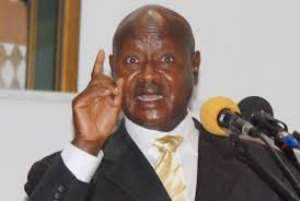
The number of districts in Uganda has increased from 33 in 1986 when Museveni captured power in 1986, to 112 on July 1, 2010 with the creation of Serere District in Teso. 25 more districts have been created this financial year making it a record 137 Districts. Uganda, according to a 2008 London School of Economics study, has the largest number of highest-level, sub-national administrative units and the smallest population per unit. Mr. Museveni says the districts are meant to bring services closer to people. We dismiss this argument.
Districts only serve to increase public expenditure and buy Museveni populist political support, but it is a very expensive venture. This is what happens to the national coffers when a new district is created. When salaried jobs are created, expenditure on what a 1980s government commission termed "unproductive costs" tends to soar.
Every new district will have the same amount of bureaucracy as an older one. With new staff come new demands – salaries, allowances, vehicles, fuel, office space – and these take up a huge chunk of the budget. Case: During the 2009/2010 financial year, Soroti District local government had a budget of roughly Shs 20.4 billion, of which 43% went on wages. Another 28% went on recurrent operational costs, leaving barely 29% for development expenditure. Soroti, the more established district out of which Serere was curved raises very little tax revenue (barely 2% of the budget) and mostly survives on central government grants. The situation has not changed much in 2015.
The Museveni-led NRM government does not have a record of cost saving, nor does it have a plan to bring quality services closer to the people. They only seek to play with political emotions of people by irrationally creating tiny districts to satisfy the short - term demands of political leaders who want to get mileage from cosmetic offers.
A district does not necessarily bring services to the people when the service delivery is hampered by underfunding, inadequacy of technical manpower due to nepotistic bottlenecks, inadequate pay, and endemic corruption at all government levels.
The wanton creation of districts by Mr. Museveni is a diversionary tactic to deflect the demands of the electorate for health services, and better education for their children and development infrastructure. People don't want another Resident District Commissioner (RDC). They want another doctor at their health centre. The same trend is being adopted in the creation of ministries as well.
With the creation of 25 more districts we are appalled that every county will become a district and every district will have a ministry. Fortunately, Museveni's NRM will not have the chance to balkanize the country further after the 2016 elections. We shall be in charge as in a government of National Unity we promise to establish or to be part of. We have no pretensions. No single political formation will be able to govern Uganda alone, but along with other actors.
Shall we abolish the new districts when we comes to power? No. We shall implement a regional development plan that would cluster all existing districts under regions thus reducing the burden of individual servicing of minute administrative units that cannot raise more than 20% of their budgets. Some district departments will be scrapped and placed under the regional development outfit, to reduce duplication of roles and to ensure vital savings by re-deploying hitherto redundant district officials to sectors where they would be more productive.
A coalition led by myself, or another person whom where I will participate will establish leaner district administrations and more specialized services will be transferred to the regional level.
Omar Kalinge is Uganda’s Aspiring Presidential Candidate 2016.
Feedback: [email protected]




 We’ll protect state wealth from opaque deals – Prof Jane Naana
We’ll protect state wealth from opaque deals – Prof Jane Naana
 Mauritania president says running for second term in June polls
Mauritania president says running for second term in June polls
 I won't ever say I was a mere driver’s mate' — Prof. Opoku-Agyemang
I won't ever say I was a mere driver’s mate' — Prof. Opoku-Agyemang
 2024 polls: 'EC struggling to defend credibility'— Prof. Opoku-Agyemang
2024 polls: 'EC struggling to defend credibility'— Prof. Opoku-Agyemang
 Akufo-Addo gov't's 'greed, unbridled arrogance, unrestrained impunity, sheer dis...
Akufo-Addo gov't's 'greed, unbridled arrogance, unrestrained impunity, sheer dis...
 Election 2024: Ghana needs an urgent reset, a leadership that is inspiring – Ma...
Election 2024: Ghana needs an urgent reset, a leadership that is inspiring – Ma...
 Partner NDC to rollout a future of limitless prospects – Prof Jane Naana Opoku-A...
Partner NDC to rollout a future of limitless prospects – Prof Jane Naana Opoku-A...
 NPP will remain in gov’t till Jesus comes — Diana Asamoah
NPP will remain in gov’t till Jesus comes — Diana Asamoah
 Sunyani Technical University demands apology from former SRC president over sex-...
Sunyani Technical University demands apology from former SRC president over sex-...
 'Dumsor' was resolved by Mahama but ‘incompetent' Akufo-Addo has destroyed the g...
'Dumsor' was resolved by Mahama but ‘incompetent' Akufo-Addo has destroyed the g...
